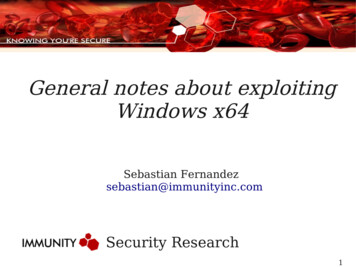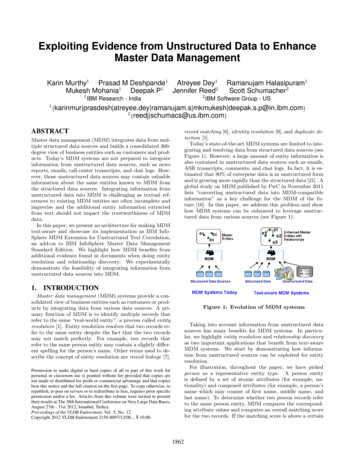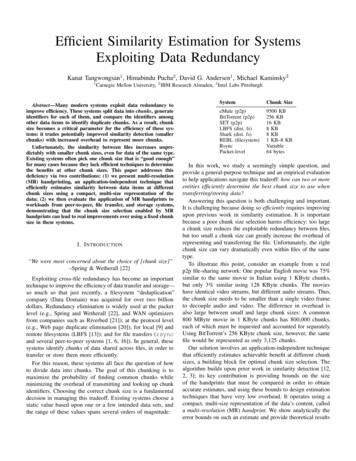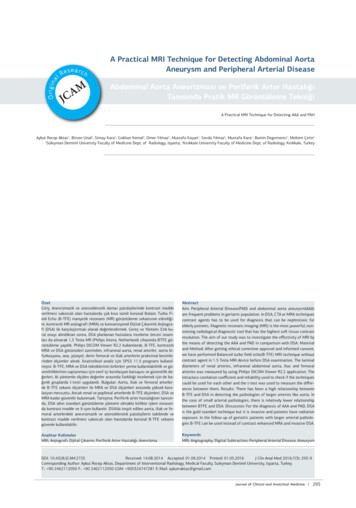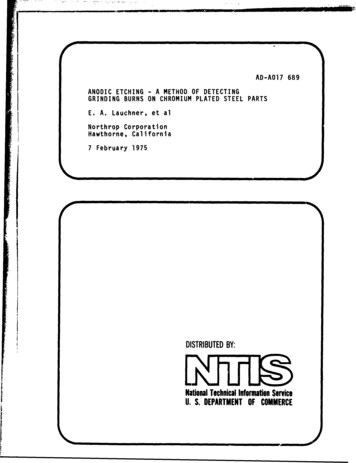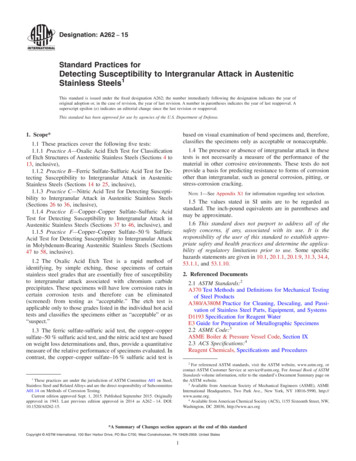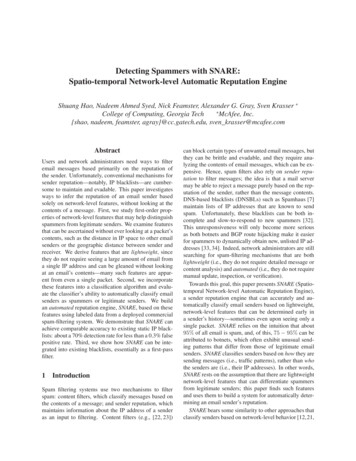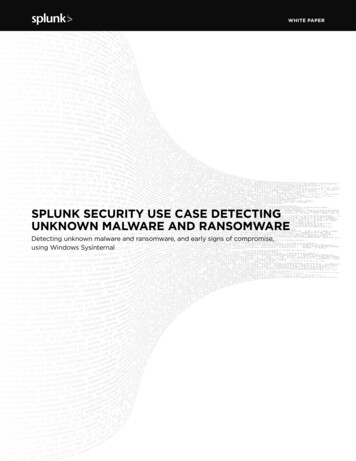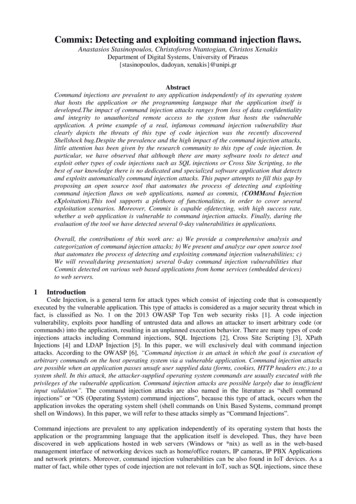
Transcription
Commix: Detecting and exploiting command injection flaws.Anastasios Stasinopoulos, Christoforos Ntantogian, Christos XenakisDepartment of Digital Systems, University of Piraeus{stasinopoulos, dadoyan, xenakis}@unipi.grAbstractCommand injections are prevalent to any application independently of its operating systemthat hosts the application or the programming language that the application itself isdeveloped.The impact of command injection attacks ranges from loss of data confidentialityand integrity to unauthorized remote access to the system that hosts the vulnerableapplication. A prime example of a real, infamous command injection vulnerability thatclearly depicts the threats of this type of code injection was the recently discoveredShellshock bug.Despite the prevalence and the high impact of the command injection attacks,little attention has been given by the research community to this type of code injection. Inparticular, we have observed that although there are many software tools to detect andexploit other types of code injections such as SQL injections or Cross Site Scripting, to thebest of our knowledge there is no dedicated and specialized software application that detectsand exploits automatically command injection attacks. This paper attempts to fill this gap byproposing an open source tool that automates the process of detecting and exploitingcommand injection flaws on web applications, named as commix, (COMMand InjectioneXploitation).This tool supports a plethora of functionalities, in order to cover severalexploitation scenarios. Moreover, Commix is capable ofdetecting, with high success rate,whether a web application is vulnerable to command injection attacks. Finally, during theevaluation of the tool we have detected several 0-day vulnerabilities in applications.Overall, the contributions of this work are: a) We provide a comprehensive analysis andcategorization of command injection attacks; b) We present and analyze our open source toolthat automates the process of detecting and exploiting command injection vulnerabilities; c)We will reveal(during presentation) several 0-day command injection vulnerabilities thatCommix detected on various web based applications from home services (embedded devices)to web servers.1IntroductionCode Injection, is a general term for attack types which consist of injecting code that is consequentlyexecuted by the vulnerable application. This type of attacks is considered as a major security threat which infact, is classified as No. 1 on the 2013 OWASP Top Ten web security risks [1]. A code injectionvulnerability, exploits poor handling of untrusted data and allows an attacker to insert arbitrary code (orcommands) into the application, resulting in an unplanned execution behavior. There are many types of codeinjections attacks including Command injections, SQL Injections [2], Cross Site Scripting [3], XPathInjections [4] and LDAP Injection [5]. In this paper, we will exclusively deal with command injectionattacks. According to the OWASP [6], “Command injection is an attack in which the goal is execution ofarbitrary commands on the host operating system via a vulnerable application. Command injection attacksare possible when an application passes unsafe user supplied data (forms, cookies, HTTP headers etc.) to asystem shell. In this attack, the attacker-supplied operating system commands are usually executed with theprivileges of the vulnerable application. Command injection attacks are possible largely due to insufficientinput validation”. The command injection attacks are also named in the literature as “shell commandinjections” or “OS (Operating System) command injections”, because this type of attack, occurs when theapplication invokes the operating system shell (shell commands on Unix Based Systems, command promptshell on Windows). In this paper, we will refer to these attacks simply as “Command Injections”.Command injections are prevalent to any application independently of its operating system that hosts theapplication or the programming language that the application itself is developed. Thus, they have beendiscovered in web applications hosted in web servers (Windows or *nix) as well as in the web-basedmanagement interface of networking devices such as home/office routers, IP cameras, IP PBX Applicationsand network printers. Moreover, command injection vulnerabilities can be also found in IoT devices. As amatter of fact, while other types of code injection are not relevant in IoT, such as SQL injections, since these
devices do not include a database, command injections are pervasive in IoT[7]. This is due to the fact thatIoT devices run an embedded OS (i.e., typically Linux), thus executing system commands. It is even morealarming the fact that the security of IoT is of paramount importance, since a vulnerability in these devicesmay lead to privacy breach [8], data loss, or even put human life in risk. Moreover, it is noteworthy thatmany IoT devices lack a patching procedure to fix bugs and vulnerabilities[9]. That is, there is no automaticand sometimes not even manual-procedure to update the vulnerable software, meaning that vulnerable IoTdevices may indefinitely remain at risk once a command injection vulnerability has been discovered.The impact of command injection attacks ranges from loss of data confidentiality and integrity tounauthorized remote access to the system that hosts the vulnerable application. In particular, an attacker cangain access to resources that he/she does not have privileges to directly accessing them, such as system filesthat include sensitive data (e.g., passwords). Moreover, an attacker can perform various malicious actions tothe vulnerable system, such as delete files or add new system users for remote access and persistence. Aprime example of a real, infamous command injection vulnerability that clearly depicts the threats of thistype of code injection was the recently discovered (i.e., disclosed in 2014) Shellshock bug [10]. The latterwas a high profile vulnerability that could potentially compromise millions of unpatched servers, routers, IoTdevices, and, in general any system connected to the internet [11]. Attackers actively exploited Shellshock bycreating botnets of compromised computers and systems to perform distributed denial-of-service attacks,phishing campaigns and vulnerability scanning [11]. Apart from Shellshock, in the past many well-knownand widely deployed web applications have been discovered to be vulnerable to command injection attacksincluding Citrix Access Gateway [14], Symantec Web Gateway [13], IBM Tealeaf CX [14] and Sophos WebProtection Appliance [15].The above observations are clear indications that command injections attacks are one of the most dangerousclass of code injections attacks that can be found nearly in all network devices that handle input data. Despitethe prevalence and the high impact of the command injection attacks, little attention has been given by theresearch community to this type of code injection. In particular, we have observed that there are manysoftware tools to detect and exploit other types of code injections such as SQL injections (i.e.,sqlmap,SQLninja, BSQL Hacker etc.) or Cross Site Scripting (i.e., OWASP Xenotix XSS ExploitFramework, XSSer, etc). However, to the best of our knowledge there is no dedicated and specializedsoftware application that detects and exploits automatically command injection attacks. We have onlydiscovered some custom scripts [16] that have been written occasionally by researchers in order to exploitonly a specific vulnerable version of a particular application. Thus, these scripts cannot be considered asgeneric tools for command injection detection and exploitation. Moreover, there are some third party pluginsfor security frameworks (e.g., Burp suite, IronWASP) that aim at detecting command injection attacks inautomated manner. However, these plugins have very limited functionality (for instance they do not supportpost-exploitation functionality to upload a backdoor automatically or they support very trivial commandinjection scenarios). Finally, some of these plugins are paid as extra services.This paper attempts to fill this gap by proposing an open source tool that automates the process of detectingand exploiting command injection flaws on web applications, named as commix, (COMMand InjectioneXploitation). More specifically, first we define, categorize and elaborate on command injectionsfor thebetter understanding of this attack vector. Next, we present and analyze the software architecture of Commixas well its broad functionality that greatly facilitate the detection and exploitation of command injectionvulnerabilities.During the evaluation of Commix, we have observed that our tool able to detect, with highsuccess rate, whether a web application is vulnerable to command injection attacks. Moreover, we haveidentified several 0-day command injection vulnerabilities in various applications.The rest of the paper is organized as follows. Section 2 elaborates on command injections, while Section 3analyzes the software architecture of Commix and highlights its advantageous characteristics. Finally,Section 4 includes countermeasures.2Analysis of Command InjectionsCommand injections vulnerabilities may be present in applications which accept and process systemcommands from the user input (see Figure 1). The purpose of a command injection attack is the insertion ofan operating system command through the data input to the vulnerable application which in turn executes theinjected command (see Figure 1). It is worth noting that command injection attacks are OS-independent that
can occur in Windows, Linux, or Unix operating systems as well as programming language-independent thatmay occur in applications written in various programming languages (such as C, C , C#, JAVA, PHP, Perl,Python, Ruby etc.) or web-based applications written in Web Application Frameworks (such as ASP.NET,CGI, Python Django, Ruby on Rails etc.). The main reason that an application is vulnerable to commandinjection attacks is due to incorrect or complete lack of input data validation by the application itself.Figure 1: Command injection attackIn general, we identify two main categories of command injections. In the first category, which is namedresults-based command injections, the vulnerable application outputs the results of the injected command.Thus, the attacker can directly infer if his/her command injection succeeded or not. The second category isnamedblind command injections. As it name implies, in this attack, the vulnerable application does notoutput the results of the injected command, and, therefore, these (i.e., the results) are not visible to theattacker. In the following, we elaborate on the two aforementioned command injection categories.2.1Results-based command injections.As mentioned previously, in results-based command injection attacks the attacker can directly infer the resultof the injected command through the response of the web application. We divide results-based commandinjection attacks into the following two techniques.2.1.1 Classic results-based command injectionThe classic results-based technique is the simplest and most common command injection attack. Morespecifically, the attacker makes use of several common operators, which either concatenate the initialgenuine commands with the injected ones or exclude the initial genuine commands executing only theinjected ones.2.1.2 Dynamic code evaluation techniqueCommand injections through dynamic code evaluation take place when the vulnerable application uses the“eval()” function, which is used to dynamically execute code that is passed (to the “eval()” function) atruntime. Thus, the dynamic code evaluation can also characterized as “executing code, which executescode”, since the “eval()” function is used to interpret a given string as code. Note that the “eval()” functionis provided by many interpreted languages such as Java, Javascript, Python, Perl, PHP and Ruby.2.2Blind Command InjectionsThe main difference between results-based command injection attacks and blind command injection attackslies to the way that the data is retrieved after the execution of the injected shell command. More specifically,we have observed that there are cases where an application, after the execution of the injected command doesnot return any result back to the attacker. In these cases, the attacker can indirectly infer the output of the
injected command using the following two techniques.We divide blind command injection attacks into twodifferent techniques: Time-based and File-based. In the following, we elaborate on these two techniquesusing code examples, in order to gain a better understanding of blind command injections, since these (i.e.,blind command injections) have not been analyzed in the literature as extensively as results-based.2.2.1 Time-based techniqueThrough this technique, an attacker injects and executes commands that introduce time delay. By measuringthe time it took the application to respond, the attacker is able to identify if the command executedsuccessfully or failed. Note that the function in Bash shell that can introduce time delays is “sleep”. Thus,by observing time delays the attacker is capable of deducing the result of the injected command.More specifically, assume the vulnerable web application, shown in Figure 2. This application takes as anargument an IP address, via the GET “addr” parameter. Thereafter, the shell command "ping" is executed,through the “exec()” PHP function, against that given IP address four times. Since there is no echo function,this snippet will not return the results of the ping command execution back to the screen. Therefore, anattacker even if he/she injects a command (e.g., “whoami”), the results will not be shown in the screen. ?phpif (isset( GET["addr"])){exec("/bin/ping -c 4 ". GET["addr"]);}? Figure 2 : Code snippet of “blind.php” file.Let assume that the attacker wants to inject, execute and read the output of the “whoami” command usingtime-based command injection. Note that the “whoami” command returns the effective username of thecurrent user. In this case, the attacker can use a chain of commands that brute forces letter-by-letter theoutput. More specifically, the attacker sends the following HTTP request with the injected chain ofcommands (see figure 3):http://vuln.web.app/blind.php?addr 127.0.0.1 ; str (whoami tr ' \n''' cut -c 1 od -N 1 -i head -1 tr -s '' cut -d'' -f 2); if [ "119" ! {str} ]; then sleep 0; else sleep 1; fiFigure 3 : Attack vector that brute forces letter-by-letter the output.The injected chain of commands can be more easily understood in the following format:; -- Semicolon Operator for the Command injectionstr (whoami tr ' \n''' cut -c 1 od -N 1 -i head -1 tr -s '' cut -d '' -f 2); -- Determine the first letter of“whoami” execution's result.if [ "119" ! {str} ];then sleep 0; -- Falseelse sleep 1; -- TruefiFigure 4 : A chain of commands that brute forces letter-by-letter the output.The above chain of commands shown in figure 4 (i.e., the piping of the command “whoami” with “cut”,“od”, “head” and “tr”) obtains the first letter of the output of “whoami” command and converts it to therespective ASCII number. Next, the chain of commands check if this letter is the first character of the ASCIItable by checking if it is equal to the ASCII 119 (i.e., the letter “a”), using the same time-delay technique asbefore. If it is, then the attacker continues with the second letter of the output. If it is not, then the attackershould check the next character of the ASCII table which is ASCII 120 (i.e., the letter “b”). This procedurecontinues until all the characters of the output are found. It is worth noting that through this technique, theprocess of finding a 8-characters long text (i.e., “www-data”) takes about 10 seconds maximum, since thediscovery of each character can take up to 1.25 seconds.
2.2.2 File-based techniqueThe rationale behind this technique is based on a very simple logic: when the attacker is not able to observethe results of the execution of an injected command, then he/she can write them to a file, which is accessibleto the attacker. This command injection technique follows exactly the same methodology as the Classicresults-based technique with the main difference that, after the execution of the injected command, an outputredirection is performed using the “ ” operator, in order to save the output of the command to a text file.Due to the logic of this technique, the file-based can be also classified as “semiblind” command injectiontechnique, as the random text file containing the results of the desired shell command execution is visible toeveryone. In particular, the attacker can send the following HTTP GET request to the same vulnerable webapplication shown in figure 2.http://vuln.web.app/blind.php?addr 127.0.0.1 ; (whoami) UVlLSE5S.txtFigure 5 : Execution of the “whoami” command, while the output is saved in a text file.Next, the attacker can trivially read the newly created file UVlLSE5S.txt as follows:http://vuln.web.app/UVlLSE5S.txtFigure 6 : The attacker can trivially read the text file that includes the output of the injected command.An essential prerequisite to achieve this, is that the root directory on the web server (i.e., “/var/www/”)should be writable by the user that is running the web server (i.e. “www-data”). In case the root directory ofthe web server is not writable, an alternative solution for the attacker is to use temporary directories, such as“/tmp” or “/var/tmp” to store in a text file the output of the injected command. The limitation in thissolution is that the attacker cannot read files located in these temporary directories through the webapplication, due to his/her limited privileges. To bypass this limitation, the attacker can apply the time-basedblind command injection technique to read the contents of the text file. For example, the attacker can use thefollowing HTTP GET request, in order to store the output of “whoami” command to a random file (i.e“/tmp/UvlLSE5S.txt”) and subsequently how many characters there are in this file.3 COMMIX3.1 Software architectureCommix [17] aims to greatly facilitate web developers, penetration testers and security researchers totest web applications with the view to find bugs, errors or vulnerabilities related to command injectionattacks. Commix is written in Python (version 2.6. or 2.7) and runs in both Unix-based (i.e Linux, Mac OSX) and Windows OS. Commix takes a URL address (from any website) as an input with a GET/POSTparameter. Then, the imported data is altogether investigated for command injection vulnerabilities.As shown in Figure 7, the general structure of the tool is divided into three main modules: i) the AttackVector Generator module, ii) the Vulnerability Detection module, and ii) the Exploitation module. TheAttack Vector Generator module as it name implies, generates a set of command injection attack vectors.The latter are produced from a command injection separators list and the type of command injection that willbe performed (i.e., Classic, Dynamic code evaluation, Blind-based and File-Based). In this way, for eachtype of attack a set of different attack vectors are generated and passed to the Vulnerability detection engine.The latter performs the command injection to the HTTP parameters of the vulnerable web application usingone by one the received attack vectors. It is important to mention that although the two most common attackvectors are usually supplied to the web application through HTTP GET and POST method parameters,commix supports injecting commands in HTTP parameters, such as HTTP cookie, HTTP User-Agent andReferer header values.
Figure 7: Commix Software ArchitectureIf the detection module determine
including Citrix Access Gateway [14], Symantec Web Gateway [13], IBM Tealeaf CX [14] and Sophos Web Protection Appliance [15]. The above observations are clear indications that command injections attacks are one of the most dangerous class of code injections attacks that can be found nearly in all network devices that handle input data. Despite
